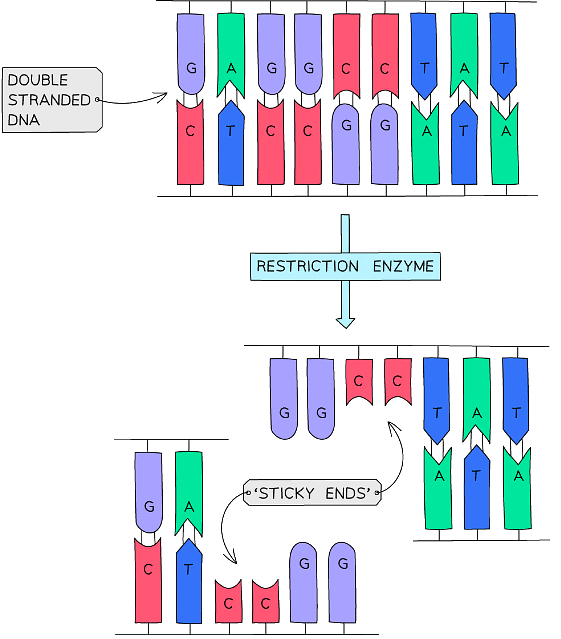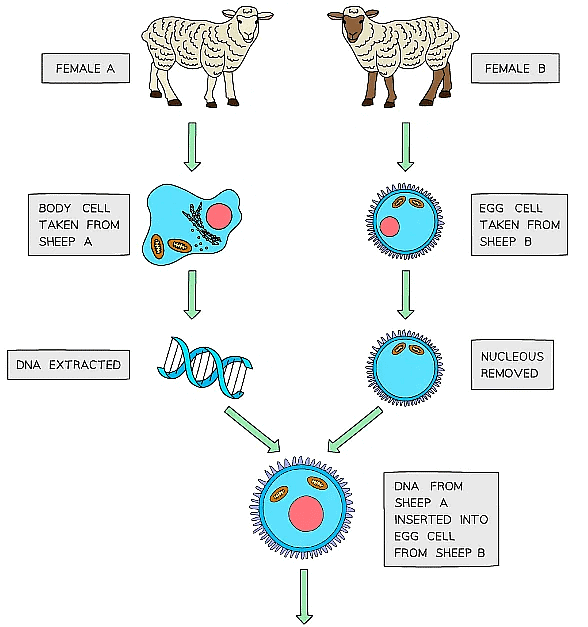Grade 10 Exam > Grade 10 Notes > Biology for Grade 10 > Genetic Engineering & Cloning
Genetic Engineering & Cloning | Biology for Grade 10 PDF Download
Genetic Engineering: Basics
- Genetic engineering is changing the genetic material of an organism by removing or altering genes within that organism, or by inserting genes from another organism
- The organism receiving the genetic material is said to be ‘genetically modified’, or is described as a ‘transgenic organism’
- The DNA of the organism that now contains DNA from another organism as well is known as ‘recombinant DNA’
Plant Genetic Engineering
- Genetically modified plants are plants that have had foreign DNA inserted into their genome
- This is usually done to improve food production in some way
- For example:
- Tomatoes have been genetically modified to make them grow larger fruit
- Wild rice has been genetically modified to produce beta carotene (needed by humans to make vitamin A)
- Crop plants have been genetically modified to be resistant to diseases or resistant to certain herbicides
Bacteria Genetic Engineering
Genetic modification of bacteria to produce human insulin
- The gene for human insulin has been inserted into bacteria which then produce human insulin which can be collected and purified for medical use to treat people with diabetes
- The gene that is to be inserted is located in the original organism – the gene for insulin production is located within a human chromosome
- Restriction enzymes are used to isolate or ‘cut out’ the human insulin gene, leaving it with ‘sticky ends’ (a short section of unpaired bases)
- A bacterial plasmid is cut by the same restriction enzyme leaving it with corresponding sticky ends (plasmids are circles of DNA found inside bacterial cells)
 Restriction enzymes cut DNA strands at specific sequences to form ‘sticky ends’
Restriction enzymes cut DNA strands at specific sequences to form ‘sticky ends’ - The plasmid and the isolated human insulin gene are joined together by DNA ligase enzyme
- If two pieces of DNA have matching sticky ends (because they have been cut by the same restriction enzyme), DNA ligase will link them to form a single, unbroken molecule of DNA
- The genetically engineered (recombinant) plasmid is inserted into a bacterial cell
 DNA ligase is used to join two separate pieces of DNA together – the recombinant plasmid is then inserted into a bacterial cell
DNA ligase is used to join two separate pieces of DNA together – the recombinant plasmid is then inserted into a bacterial cell - When the bacteria reproduce the plasmids are copied as well and so a recombinant plasmid can quickly be spread as the bacteria multiply and they will then all express the human insulin gene and make the human insulin protein
- The genetically engineered bacteria can be placed in a fermenter to reproduce quickly in controlled conditions and make large quantities of the human protein
Advantages & Disadvantages of Genetic Engineering
Advantages & disadvantages of GM crops table

GM Crops
- Crops can be genetically modified (they are known as GM crops)
- Crop plants, such as wheat and maize, have been genetically modified to contain a gene from a bacterium that produces a poison that kills insects, making them resistant to insect pests such as caterpillars. This can improve crop yields
- Crop plants have also been genetically modified to make them resistant to certain herbicides (chemicals that kill plants), meaning that when the herbicide is sprayed on the crop it only kills weeds and does not affect the crop plant
- Some crops have been genetically modified to produce additional vitamins and improved nutritional value, eg. ‘golden rice’ contains genes from another plant and a bacterium which make the rice grains produce a chemical that is turned into vitamin A in the human body, which could help prevent deficiency diseases in certain areas of the world
- Some have been genetically modified to be drought-resistant (to grow better in very dry conditions). This can also improve crop yields
- Concerns about GM crops include the effect on populations of wildflowers and insects
- Some people feel the effects of eating GM crops on human health have not been fully explored
Curing Diseases with Genetic Engineering
- Modern medical research is exploring the possibility of genetic modification to overcome some inherited disorders
- As these inherited genetic diseases are caused by faulty genes, it may be possible to treat these by inserting working versions of these genes into people with the genetic disease
- This is called gene therapy
The Process of Genetic Engineering
Higher Tier Only
- The main steps in the process of genetic engineering:
- Enzymes are used to isolate (cut out) the required gene
- This gene is inserted into a vector
- The vector is usually a bacterial plasmid (a piece of circular DNA found inside bacterial cells) or a virus
- The vector is used to insert the gene into the required cells of the target organism
- Genes are transferred to the cells of animals, plants or microorganisms at an early stage in their development so that they develop with desired characteristics
Tissue Culture
- Tissue culture is a process in which very small pieces of plants (‘tissue’) are grown (‘cultured’) using nutrient media
- Because they are initially grown in petri dishes on nutrient agar we say they are grown ‘in vitro’ – outside a living organism
- How to propagate plants in vitro:
- Cells are scraped from the parent plant (these cells are known as explants)
- The cells are transferred to a sterile petri dish containing nutrient agar
- Hormones (eg. auxins) are added to encourage plants to grow into small masses of tissue (callus tissue)
- Tissue continues to grow and forms plantlets that can be transferred to individual potting trays and develop into plants
 Tissue culture: using small groups of cells from part of a plant to grow identical new plants
Tissue culture: using small groups of cells from part of a plant to grow identical new plants
- Clones are genetically identical individuals
- The cloning of plants has many important commercial uses
- It allows a variety of a plant with desirable characteristics to be produced:
- cheaply
- with a greater yield (a large number of plants can be produced)
- quickly
- at any time of the year
- It can also ensure diseases prevalent in other areas of the world are not imported and spread by ensuring native varieties of plants are produced in large enough quantities to supply demand in one country without importing plants from abroad
- Tissue culture can also be an important process in preserving rare plant species
Cuttings
- An older and more simple method to clone plants (mainly used by gardeners) is by taking cuttings
- Gardeners take cuttings from good parent plants (eg. those that are healthiest and best-looking) – a section of the parent plant with a new bud is cut off
- These cuttings are then planted and grow into genetically identical versions of the original plant
- Plants cloned by taking cuttings can be produced cheaply and quickly
Embryo Cloning
- It is possible to clone animals using embryo transplants
- For example, if a farmer wants the best cattle, they must first create an offspring from the best bull and best cow, and then clone this offspring to create many genetically identical copies (clones)
- This process is known as embryo cloning and is achieved in the following way:
- Egg cells from the best cow are artificially fertilised using sperm cells taken from the best bull
- This forms an embryo
- The developing animal embryo is then split apart many times before the cells of the embryo become specialised
- This forms many separate embryos that are genetically identical
- These cloned embryos are then transplanted into host mothers
- The calves born from these host mothers are all genetically identical

 Embryo cloning
Embryo cloning
Adult Cell Cloning
- Adult cell cloning is achieved in the following way:
- The nucleus is removed from an unfertilised egg cell
- The nucleus from an adult body cell, such as a skin cell, is inserted into the egg cell
- A very small electric shock stimulates the egg cell to divide (by mitosis) to form an embryo
- These embryo cells contain the same genetic information as the adult skin cell
- When the embryo has developed into a ball of cells, it is inserted into the womb of an adult female (known as the surrogate mother) to continue its development until birth
- This process was used to create the first clone (exact genetic copy) of a mammal in 1996
- Scientists in Scotland successfully cloned an adult female sheep
- The clone was called Dolly

 Adult cell cloning: the cloning technique used to produce the first cloned mammal, Dolly the sheep
Adult cell cloning: the cloning technique used to produce the first cloned mammal, Dolly the sheep
Benefits & risks of cloning table

The document Genetic Engineering & Cloning | Biology for Grade 10 is a part of the Grade 10 Course Biology for Grade 10.
All you need of Grade 10 at this link: Grade 10
|
110 videos|93 docs|9 tests
|

|
Explore Courses for Grade 10 exam
|

|
Signup for Free!
Signup to see your scores go up within 7 days! Learn & Practice with 1000+ FREE Notes, Videos & Tests.
Related Searches
























